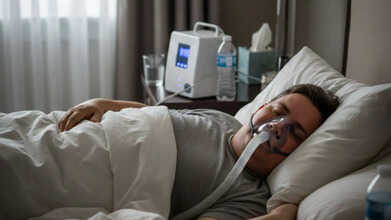- Health Conditions A-Z
- Health & Wellness
- Nutrition
- Fitness
- Health News
- Ayurveda
- Videos
- Medicine A-Z
- Parenting
Weight Loss Drug Mounjaro Gets Nod For Sleep Apnea: How Does It Work?

Credits: Gemini
A very common medical condition globally, sleep apnea is a disorder that interrupts breathing during sleep. Several factors can cause it, though the risk rises sharply with obesity because extra fat in the neck, known as pharyngeal fat, can narrow the airway. Health professionals usually advise lifestyle changes such as diet and exercise to ease symptoms, but if these steps do not help enough, weight-loss injections may be recommended.
Australia’s Therapeutic Goods Administration (TGA) has now approved the weight-loss drug Mounjaro as a treatment option for sleep apnea, a condition where a person repeatedly stops and starts breathing through the night. The TGA states that Mounjaro may be used for adults with moderate to severe obstructive sleep apnea who also meet the criteria for obesity with a body-mass index of 30 or more.
The United States Food and Drug Administration cleared the same drug for this purpose last year. This raises an important question. How could a medicine known mainly for weight management and type 2 diabetes support people struggling with sleep apnea?
What Is Sleep Apnea?
Obstructive sleep apnea affects close to a billion people worldwide. It causes repeated pauses in breathing that disrupt sleep and reduce oxygen levels. Many people notice loud snoring, choking or gasping, and heavy daytime fatigue. The main forms are obstructive sleep apnea (OSA), caused by a blocked airway, and central sleep apnea (CSA), which occurs when the brain does not send the right signals to the breathing muscles. If ignored, it can raise the risk of high blood pressure, heart disease and stroke, according to the Mayo Clinic.
How Does Obesity Trigger Sleep Apnea?
Obesity is one of the strongest contributors to obstructive sleep apnea. Roughly 80% of people diagnosed with the condition also live with obesity. The link runs in both directions. Extra fat around the neck can make the airway narrower and disturb breathing.
At the same time, sleep apnea can interfere with hunger and satiety hormones such as ghrelin and leptin, which can encourage overeating. Persistent tiredness makes it harder to stay active or maintain healthy habits, creating a cycle in which both problems feed into each other.
How Can Mounjaro Help With Sleep Apnea?
Mounjaro is the brand name for tirzepatide, also sold elsewhere under names like Zepbound. It works by activating receptors for two gut hormones known as GLP-1 and GIP. These hormones help control appetite, food intake and blood sugar. They are normally released when we eat, but tirzepatide mimics their action so people feel satisfied with smaller portions. Eating less overall can lead to gradual weight loss, which may improve sleep apnea symptoms in those whose condition is tied to obesity.
Mounjaro Side Effects
Although Mounjaro may be useful for some adults with sleep apnea, digestive side effects are fairly common. People may experience nausea, vomiting, diarrhoea, constipation or a drop in appetite. These issues often lessen as the body adjusts. Some users have also noted gallbladder-related concerns.
Even with these drawbacks, interest in Mounjaro as a sleep apnea therapy is growing because it offers a drug-based option for a condition long treated mainly with devices such as CPAP machines. Still, the medication is meant for people with obesity, and not everyone with sleep apnea falls into that category.
It is always best to speak with a healthcare provider before beginning or stopping any prescribed treatment.
UK Health Experts Issue Antibiotics Alert For Cold and Flu; Here’s Why

Credits: Canva
Health authorities in the United Kingdom have released a fresh advisory on the use of antibiotics this winter. The UK Health Security Agency (UKHSA) reminded the public that these medicines are designed for specific types of illness and are not useful in every situation.
Antibiotics treat or prevent bacterial infections by killing the bacteria outright or limiting their ability to grow. This allows the body’s own immune defences to clear the remaining infection. What they cannot do is treat illnesses caused by viruses.
This includes common winter infections such as colds, flu, and COVID-19. In a post on X, the UKHSA said, “Antibiotics don't work for colds and flu. Pharmacists can guide you on managing your symptoms.”
Health Officials Issue Winter Antibiotics Warning
The agency also urged people to keep a few basic points in mind when using antibiotics:
- Do not use them for colds or flu
- Do not keep unfinished courses for future use
- Always take them according to instructions
Flu And Cold: Why The Warning Matters
The reminder follows the release of the UKHSA’s English Surveillance Programme for Antimicrobial Utilisation and Resistance (ESPAUR) report, which shows that nearly 400 people in England each week are now diagnosed with infections that no longer respond well to antibiotics. These resistant infections are harder to treat and pose a greater risk of complications.
Experts believe that years of unnecessary or incorrect use of antibiotics have contributed to a decline in their effectiveness. This widespread overuse has also encouraged the rise of “superbugs”, a term used for bacteria that can withstand several commonly used antibiotics. Examples highlighted by the NHS include:
- MRSA (methicillin-resistant Staphylococcus aureus)
- Clostridium difficile (C. diff)
- The bacteria responsible for multi-drug-resistant tuberculosis
The NHS notes that these infections can be severe, difficult to control, and are becoming a growing cause of illness and death worldwide. The larger concern is that entirely new bacteria may emerge with resistance to every antibiotic currently available.
Cold Symptoms
A cold usually develops slowly and tends to be milder. Typical signs include a runny or blocked nose, sneezing, a sore throat, mild cough, slight body ache, and low fever if any. Many people also feel pressure around the sinuses and a mild headache.
Flu Symptoms
Flu sets in quickly and is generally more intense. People often experience a high fever, chills, deep muscle pain, marked fatigue, headache, dry cough, sore throat, and a sudden drop in energy. Some may also have nausea, loss of appetite, or chest discomfort.
What Experts Are Saying
Dr Alicia Demirjian, consultant epidemiologist and clinical lead for antimicrobial resistance and prescribing at the UKHSA, said, “Antibiotic resistance is one of the biggest threats facing modern medicine, but the good news is we can all do something about it.”
If a doctor has prescribed antibiotics, it is vital to take the medicine exactly as told, without skipping or delaying doses.
The NHS advises, “If you miss a dose, check the patient information leaflet to see what to do. If you are unsure, speak with a pharmacist or your GP. In many cases, you can take the missed tablet as soon as you remember and then continue the course as usual. If it is almost time for your next dose, leave out the missed one and return to your usual schedule.”
Three-Year-Old Boy With Rare Hunter Syndrome Makes History As Breakthrough Gene Therapy Halts His Disorder

Credits: Canva
A three-year-old boy from California has stunned doctors with his rapid progress after receiving a world-first gene therapy for Hunter syndrome, a rare inherited condition that causes progressive damage to the body and brain. The treatment was carried out at the Royal Manchester Children’s Hospital and offers new hope for families who have long lived with the devastating effects of the disease.
What Is Hunter Syndrome?
Hunter syndrome is caused by a faulty gene that prevents patients from producing an enzyme needed to clear certain molecules from cells. Children appear healthy at birth but start showing symptoms around age two. The condition affects the heart, liver, bones and brain and is often described as a form of childhood dementia. Most severely affected patients rarely live beyond their teenage years.
How Doctors Tried to Halt the Disease
Before treatment, Oliver Chu could not produce the crucial enzyme, reports BBC. Conventional therapy required weekly infusions that only slowed physical decline and could not protect the brain. Doctors in Manchester decided to attempt a one-time gene therapy, something never tried before for this condition.
Stem cells were collected from Oliver’s blood in December 2024 and sent to a specialist laboratory at Great Ormond Street Hospital in London. Scientists inserted a working copy of the missing gene into a harmless virus. The virus delivered the corrected gene into Oliver’s stem cells, allowing them to produce the missing enzyme once infused back into his body. Researchers also modified the gene to help the enzyme travel more easily into the brain, a major challenge in previous treatments.
The First Infusion
In February 2025, Oliver returned to Manchester for the infusion. His corrected stem cells, about 125 million of them, arrived frozen in a cryopreservation tank. After several safety checks, nurses slowly injected two doses into a catheter in his chest. The entire process took minutes, but the hope behind it was enormous. Once the infusion was complete, Oliver and his mother returned to California to wait for results.
Signs of Improvement
By May, the effects were becoming clear. Oliver’s speech had improved, his mobility had increased, and his parents described him as “brighter” and “healthier.” Most significantly, he no longer needed the expensive weekly enzyme infusions. His body had begun producing the enzyme on its own.
His older brother Skyler, who also has Hunter syndrome, accompanied the family to Manchester during this follow-up visit. Their parents now hope Skyler may also qualify for the therapy one day.
A Year That Changed Everything
By late August, nine months after treatment, doctors confirmed that Oliver was producing far above normal levels of the missing enzyme. He was gaining new words, moving more easily and showing continued cognitive progress. Professor Simon Jones, who co-leads the trial, praised Oliver’s development but noted that researchers still need long-term data.
Five boys from the United States, Europe and Australia are enrolled in the ongoing trial. No UK patients qualified because most were diagnosed too late. Participants will be monitored for at least two years to assess effectiveness and safety.
A Trial That Nearly Collapsed
The gene therapy almost never reached patients. Researchers at the University of Manchester had spent over 15 years developing it but nearly lost funding when their biotech partner withdrew. A last-minute contribution of 2.5 million pounds from the medical charity LifeArc saved the trial and allowed children like Oliver to join.
His parents say they are “eternally grateful” and feel his life has been “reset.” For them, the treatment represents not just medical progress but a future filled with possibilities.
Winter Pollution Could Trigger Dangerous Chest Pain, Cardiologist Warns

Credits: Canva
For decades, cardiologists have noticed a clear seasonal trend. Heart attacks tend to rise during the winter months. Patients who already have heart conditions often see their health decline in the cold season, requiring more frequent and longer hospital stays. As winter approaches, pollution levels spike dramatically, making breathing more difficult, and for good reason.
Multiple factors combine to create this seasonal risk. We spoke to Dr. Vikash Goyal, Senior Cardiologist at Paras Health, Gurugram, to understand why chest pain becomes more common in winters.
Why Does Winter Trigger More Heart Risks?
Traditionally, this increase in heart-related issues has been linked to the body’s response to cold temperatures. Winter causes blood vessels to constrict and can lead to higher blood pressure, while reduced sweating may cause salt to build up in the body.
Less physical activity, along with a tendency to eat heavier, richer foods, adds to weight gain and raises blood sugar and cholesterol. Together, these factors increase the workload on the cardiovascular system, contributing to the rise in cardiac events during the winter months.
How Does Winter Pollution Trigger Chest Pain?
One constant in North Indian winters is a sharp rise in air pollution that comes alongside dropping temperatures. As the air cools and circulation slows, a thick layer of smog lingers over many cities. This pollution is a mix of vehicle emissions, construction dust, industrial smoke, and seasonal crop stubble burning. The simultaneous rise of air pollution and winter cardiac hospitalizations is too pronounced to ignore.
Dr. Vikash Goyal explained that air pollution has a significant but often overlooked effect on heart health. The heart relies on clear blood flow to support all major organs. When polluted air enters the lungs, tiny particles enter the bloodstream, triggering inflammation throughout the body. This narrows and stiffens blood vessels, forcing the heart to work harder while reducing oxygen supply to vital organs like the brain and kidneys.
He said, “This can lead to headaches, fatigue, dizziness, or worsening kidney function. During winter, the combination of cold temperatures and trapped smog thickens the blood and raises blood pressure, putting extra strain on the heart.” This explains why chest pain, breathlessness, and other cardiac issues increase during winter pollution season. Protecting yourself from polluted air isn’t just about lungs—it’s about safeguarding your whole cardiovascular system.
How Do PM2.5 Particles Harm The Cardiovascular System?
According to the World Health Organization, PM2.5 particles entering the bloodstream can cause multiple harmful effects on the heart. They trigger inflammation, destabilize cholesterol plaques, and increase the risk of plaque rupture, a common cause of heart attacks. They also create oxidative stress, producing free radicals that damage blood vessels and speed up atherosclerosis. Additionally, PM2.5 thickens the blood and makes platelets stickier, raising the chance of clots forming in blood vessels.
How To Protect Your Heart During Winter Pollution?
To reduce the impact of winter pollution on your heart, limit outdoor exposure on high-pollution days, wear N95 or N99 masks when going out, and use air purifiers and humidifiers indoors. Stay hydrated, eat foods rich in antioxidants, and keep an eye on your health.
If you notice persistent chest pain, tightness, or other concerning symptoms, seek medical help immediately.
© 2024 Bennett, Coleman & Company Limited

